-

人教版新目标初中英语九年级上册I used to be afraid of the dark教案
内容提示1.本单元主要内容是学会used to结构。Used to +动词原形表示过去经常、以前常常,只用于过去式中,用来表示现在已不存在的习惯或状态。例如:They used to play football together.他们过去常在一起蹋足球。(现在不在一起踢了)2.used to的疑问形式和否定形式为Did you use to…?和I didn’t use to… 也可以用Used you to…?和I used not to…但现在多使用前者。例如:Did you used to swim in the river? 你过去常在河里游泳吗?I didn’t use to play the piano. 我以前并不经常弹钢琴。教学目标一、学习目标(Language Goal) 1.学会陈述自己过去常做的事情。2.学会陈述自己过去的爱好等。3.能够表达自己现在和过去在外表、性格、娱乐等方面的变化。4.能够表达朋友、家人等现在和过去的变化。二、语言结构(Language Structures) 1.I used to be short when I was young. 我年轻时个子很矮。 2. —Did you use to have straight hair? 你过去是直发吗?—Yes, I did. 是的。 3. —Did you use to play the piano? 你过去弹钢琴吗?—No, I didn’t. 不,我不弹。 4.I used to be afraid of dark. 我过去害怕黑暗。 5.I’m terrified of the snakes. 我害怕蛇。

人教版新目标初中英语九年级下册By the time I got outside, the bus had already left教案
Ⅰ. Teaching Aims and Demands1. Knowledge Objects(1) Key Vocabularyoversleep(2) Target LanguageWhat happened?I overslept. And by the time I got up, my brother had already gotten in the shower.2. Ability Objects(1) Teach the students to use the new words.(2) Train the students to narrate past events with the Past Perfect Tense.(3) Train the students' listening and speaking skills with the target language.3. Moral ObjectIt’s a good habit to go to bed early in the evening and get up early in the morning. So you’ll never be in a hurry in the morning.Ⅱ. Teaching Key Points1. Key Vocabularyoversleep2. Target LanguageNarrate past events with the Past Perfect TenseⅢ. Teaching Difficult Points1. Train the students to narrate past events with the Past Perfect Tense.2. Train the students to understand the target language in spoken conversation.Ⅳ. Teaching Methods1. Thinking of examples from the students' real lives.2. Making sentences by looking at the pictures.Ⅴ. Teaching AidA tape recorderⅥ. Teaching ProceduresStep I Revision1. Revise the language points in Unit 8.Ask some questions like this: What volunteer work would you like to do?Help the students to answer, I’d like to…/I love to…/I hope to2. Practice the dialogue in Activity 3c on page 62 again. Get students to role play the similar dialogues with the following.

人教版新目标初中英语九年级下册I’ll help clean up the city parks教案
Talk about offering help (P60)I’ll help clean up the city parks.A: I’d like to work ...B: You could help ...Talk about ways to tell people about the Clean-Up Day (P61)We need to ...We can’t ...I’ll ...Talk about the work the volunteers do (P62)These three students all volunteer their time to help other people.Somebody loves to ... / helps ... / plans to ... / wants to ...A: What do you like doing?B: I like ... A: What kind of volunteer work do you think I could do?B: You could ...1. 重点词汇advertisement, fix, repair, pleasure, blind, deaf, shut, carry, specially, fetch2. 认读词汇hunger, homeless, cheer, clean-up, sign, establish, major, commitment, elementary, veterinarian, coach, similar, call-in, strategy, disabled, organization, unable, support, appreciate, donation, part of speech, pronoun, adverb, preposition, conjunction, donate, Jimmy, Sally3. 词组clean up, cheer up, give out, put off, set up, think up, take after, fix up, give away, put up, hand out, work out, at once

人教版新目标初中英语九年级下册You’re supposed to shake hands教案
教学目标:1. 掌握本单元一些重点词汇的写法和用法。2. 学会自如谈论餐桌礼仪。Step 1 RevisionAsk some students to retell the customs at the table in France in the passage in 3a.Step 2 Self checkPart 1. Fill in each bland with the correct word given. Students do the exercises by themselves at first. Then check the answers. Ask the students to comprehend the sentences and help them point out uses of some words, like “arrive (at / in) sw., spend time / money on sth , spend time / money (in) doing sth.”Part 2. Read about Fan Ling’s experience in a western restaurant. Understand the passage. Point out some key points in the passage.1. be / get used to doing sth. 习惯做某事2. begin with = start with 以….开头3. crowd v. 挤满,塞满 the crowd 人群 crowded adj. 拥挤的Then students discuss about how she would solve her problem. Ask some to share their stories with others.Part 3. Complete the crossword by looking at the sentences on the left. Then check the answers.

人教版新目标初中英语七年级上册Can you play the guitar教案
本单元主要是学习情态动词can的肯定句、否定句、一般疑问句,肯定与否定回答,以及特殊疑问句的构成和用法;复习what弓!导的特殊疑问句。本单元主要围绕“加人俱乐部,谈论自己的能力”这一话题,设计了三个任务型活动:任务一是:自己的才艺表演,学习情态动词can的用法;任务二是:自己建立俱乐部,运用情态动词can谈论自己在某一方面的能力、喜好和意愿;任务三是:我能成功,主要是复习巩固谈论各自的爱好和特长的方法。单元知识系统(树)Can you/he/she/you dance? 一Yes,I/he/she/we can./No,I/he/she/we can’t.Can Bill play the guitar?一Yes,he can,but he can’t sing.单元总体目标通过学习情态动词can的用法,使学生能够表达自己在某一方面所具备的才能;能够谈论自己的喜好与意愿;能够为自己成立的各种俱乐部制作海报;会写招聘广告。单元重难点一览重点 难点I.复习词汇:can,play,want2.词汇:guitar, dance, swim,sing, chess, speak, drum,trumpet,violin,play the guitar3.句型:Can you/he/she/you dance?Yes,I/he/she/we can./No,I/he/she/we can’t.Can Bill play the guitar?

人教版新目标初中英语七年级上册What time do you go to school教案
知识与能力复习词汇time,morning,breakfast,get up,g0 t0 bed,homework,clock,afternoon,lunch,run,watch TV,evening,dinner,eat,usually,o’clock,thirty,fifteen,take a shower,go t0 school等;引导学生复习、巩固“询问和谈论时间”的目标语言并运用所学知识安排自己的学习和课外活动。过程与方法运用Summarizing,Classifying和Comparing的学习策略。在复习教学中,运用听写、提问、对话演练与调查活动,促使学生不断地使用所学内容,从而提高他们灵活运用知识的能力。情感态度价值观本部分的主要内容是复习“日常作息时间”的询问和表达。通过互相询问或谈论自己或对方的作息时间安排和活动计划,培养学生良好的作息习惯和守时习惯。教学重、难点及教学突破重点复习词汇time,morning,breakfast,get up,g0 to bed,homework,clock,afternoon,lunch,run,watch TV,evening,dinner,eat,usually,o’clock,thirty,fifteen,take a shower,go to school等;引导学生复习、巩固“询问和谈论时间”的目标语言。

人教版新目标初中英语七年级上册What’s this in English教案
一、知识和能力目标本单元的核心教学内容是“认物”。用英语确认周围的常见事物比较符合英语初学者的实际情况。通过本单元教学,使学生运用所学句型,去熟悉周围事物的名称;教学生学会在实际生活中如何确认事物。通过辨认物体,学生学到一些生词,并巩固所学句型。二、过程和方法目标教师要尽量使学生对课文中出现的句型能够熟练上口,这样,学生才能顺利开展比较灵活的对话。教师可以用手势,表情,动作等示意,帮助学生听懂课堂教学内容,但在实际操作中应尽量避免“明知故问”的倾向,应该采用应用性原则;如:遮盖物品、显露局部、辨认物体、完形识别、图形辨认等方法。三、情感态度和价值观目标目标在学生学习过程中的作用至关重要,教师要帮助他们建立起一个切合自己实际的目标,通过渐进的学习以及一点一滴的进步,使他们逐步建立起成功感。成功越多,自信心就越强。

人教版新目标初中英语七年级下册Where is your pen pal from教案
2.1Match the country with the language.Step II Reading3a? let the students read the letter fast and answer the questions.? Let the students ask more questions about the letter as possible as the can.Step III Writing3b.Step IV. Pairwork2cStep V Listening2a, 2bStep V. HomeworkExercises book(1) P3Exercises book (2) P3Period FourStep I . Dictate the words and sentences in Unit1.Step II. Self-checkStep III. Check the answers for Exercises book in the unit.Step IV. Home workRevise and preparation for unit 2.教学反思:通过本单元的学习,学生基本可以谈论人们的国籍,居住城市及其所说的语言,通过书信方式去介绍自己并寻找笔友。但在涉及到国外的一些城市时,学生对这方面的知识相对欠缺,能介绍的城市并不多,也反应出学生课前预习不充分,这跟学生学习条件也有关,大多数学生无法通过网络获取所需信息。因此,在以后的教学中要多指导学生通过计算机网络获取信息,拓宽知识面。

人教版新目标初中英语八年级下册Would you mind turning down the music教案
Step 4. Group work (4)1. Ask a pair of students to read the dialogue. Say, This activity provides speaking, listening and writing practice using the target language.2. Ask students to complete the work in groups.3. Check the answers with the whole class. 4. Explain some of the language points. Step 5. Word review (Self check 1)1. Ask students to read the words and the phrases given. 2. Fill in the blanks with proper forms of these words to complete the sentences. 3. Check the answers with the whole class. Homework:Do activity 2 on page 57 after class. Period 6Teaching aims: 1. Teach vocabulary words and the useful expressions. 2. Enable the students to learn etiquette in different culture. 3. Help the students learn how to behave politely in public places and in daily life. Teaching procedures:Step 1. RevisionHelp students to review the function of making requests through a free talk. Then lead them to the topic of etiquette. Explain the meaning of etiquette. Or, ask students to look it up in the dictionary. Step 2. Pre-reading (Section 1)1. Ask students to read the picture and make a list with their partner about how many rules of etiquette can be seen being broken.

人教版新目标初中英语九年级上册I like music that I can dance to教案
教学目标: 1. Express preferences2. Talk about one’s likes and dislikes and the reasons3. Learn to express one’s opinions 4. Learn to write a reply 语言功能: 1) Talk about one’s preferences, using t he relative clause2) Talk about people’s likes and dislikes and the reasons3) Talk about opinions语言结构: Relative clauses with that and who语言目标:What kind of music do you like?I like music that I can sing along with.I love singers who write their own music.We prefer music that has great lyric.重点词汇及短语:heart, photography, interest, class, whatever, miss, okay, expect, sweet, taste, itself, laboratory, cancer, increase, biscuit, main, care, prefer… to…, remind somebody of …, dance to, sing along with, be sure to, interest somebody, make somebody adj., to be honest, suit somebody, on display, catch up教学重难点:What do other people think of the different kinds of things? How to express one’s opinions? 学习方式:讨论,合作学习情感目标:通过本单元的学习,能提高学生的艺术鉴赏能力和审美情趣,并引导学生养成健康的饮食习惯。课时安排5课时第一课时:Section A: 1a-2c第二课时:Section A : 3a-4第三课时:Section B:1-2c, Self check2第四课时:Section B: 3a-4, Self check1第五课时:Self check ReadingI like music that I can dance to.

人教版新目标初中英语九年级上册It must belong to Carla教案
一、Section A该部分有4个模块。第一模块围绕Whose volleyball is this? 这一话题展开思维( 1a)、听力(1b)、口语( 1c)训练;第二模块围绕上一模块中的话题进行听力( 2a-2b)、口语训练( 2c);第三模块继续围绕前两个模块中的“making inferences”展开训练。训练形式为阅读排序( 3a)和两人问答(3b);第四模块仍就上一话题展开讨论。二、Section B该部分有4个模块。第一模块要求根据图画和所提供的单词写出合理的句子;第二模块在听力( 2a-2b)和分角色口语训练( 2c)的基础上,继续进行“推测”训练; 第三模块围绕“Strange events in Bell Tower neighborhood”这一话题展开阅读( 3a)和写作(3b -3c)训练;第四模块以dream为话题展开小组活动。三、Self Check该部分有3个模块。第一模块以填空形式对所学词汇进行训练;第二模块就8个谚语展开阅读和讨论。

人教版新目标初中英语九年级下册Rainy days make me sad教案
1. 教材分析本单元以how do things affect you?为话题, 从颜色、天气、音乐、广告、产品等方面谈论了外界事物如何影响人的心情。要求学生掌握表达某物或某事给人带来的感觉、看法或影响等。共设计了四个部分的内容:Section A 该部分有4个模块:第一模块围绕Which restaurant would you like to go to?这一话题展开思维(1a)、听力(1b)、口语(1c)训练;第二模块围绕How does music affect you? 进行听力(2a-2b)、口语训练(2c);第三模块继续围绕how do colors in the restaurant affect you这一话题展开训练,训练形式为阅读和问题体验(3a)和小组活动(3b);第四模块仍就How do things affect you这一话题以调查的形式展开讨论。Section B该部分有4个模块:第一模块围绕产品广告对人们的影响这一话题以“配对”(1a)与“列举”(1b)两种形式展开训练;第二模块继续围绕How do things affect you? 进行听力(2a-2b)、口语对话训练(2c);第三模块围绕“Advertising”这一话题展开阅读(3a-3b)和写作(3c)训练;第四模块围绕How posters affect you这一话题以口语训练形式展开小组活动。

人教版新目标初中英语九年级下册Could you please tell me where the restrooms are教案
Step Ⅰ RevisionCheck homework. Ask a few students to read the article in 3a.Then ask a few students to read their guides.Step Ⅱ Part 1Look at the words in the box. Ask a student to read them. Make sure the students understand the meaning of the words. You are to fill in the blanks with the words. In some cases, students may need to use another form of the word, for example adjusting for tense or subject/ verb agreement.Ask students to fill in the blanks on their own.Check the answers. Step ⅢPart 2Go through the instructions with the class.Look at the example with the students.Ask students what the answer would be.Ask a student to read the question and answer it.Excuse me, could you tell me where the bank is, please?The bank is across the street from the shopping malt.Get students to complete the work in pairs.Check the answers. Ask a few students to read their questions.Step Ⅳ Just for Fun!Ask all the students to read the conversation. Ask: What is funny about this cartoon? Help students to explain. A Martian is a person from the planet Mars.There is no such thing as Martian food on Earth, and the clerk looks silly because he is trying to think of where there is a Martian restaurant.Invite some pairs of students to present this conversation to the rest of the class.Step Ⅴ Summary and HomeworkIn this class, we’ve done much writing practice using the key vocabulary words and the target language presented in this unit. After class, please finish the questions in 2 in your exercise books. Then finish the exercises on pages 47~48 of the workbook as well.The Seventh Period Ⅰ Teaching Aims and Demands1. Knowledge Objects(1) Key Vocabularyimage, adventure, jealousy, hero, crime, journey, brave, no longer, show interest in, take it easy, become interested in, plain looks(2)Text:Grown-ups like cartoons, too.2. Ability Objects(1) Fast-reading to get a general idea of the text.(2) Careful-reading to get the detailed information in the text.
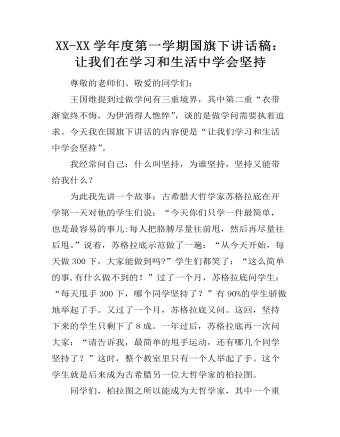
XX-XX学年度第一学期国旗下讲话稿:让我们在学习和生活中学会坚持
尊敬的老师们、敬爱的同学们:王国维提到过做学问有三重境界,其中第二重“衣带渐宽终不悔,为伊消得人憔悴”,谈的是做学问需要执着追求。今天我在国旗下讲话的内容便是“让我们学习和生活中学会坚持”。我经常问自己:什么叫坚持,为谁坚持,坚持又能带给我什么?为此我先讲一个故事:古希腊大哲学家苏格拉底在开学第一天对他的学生们说:“今天你们只学一件最简单,也是最容易的事儿:每人把胳膊尽量往前甩,然后再尽量往后甩。”说着,苏格拉底示范做了一遍:“从今天开始,每天做300下,大家能做到吗?”学生们都笑了:“这么简单的事,有什么做不到的!”过了一个月,苏格拉底问学生:“每天甩手300下,哪个同学坚持了?”有90%的学生骄傲地举起了手。又过了一个月,苏格拉底又问。这回,坚持下来的学生只剩下了8成。一年过后,苏格拉底再一次问大家:“请告诉我,最简单的甩手运动,还有哪几个同学坚持了?”这时,整个教室里只有一个人举起了手。这个学生就是后来成为古希腊另一位大哲学家的柏拉图。
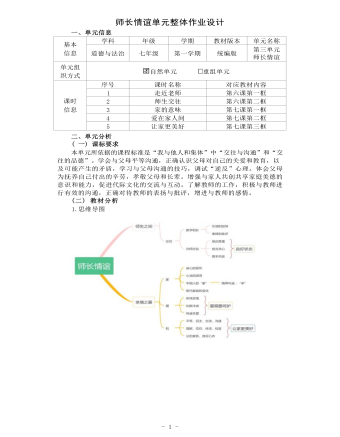
初中道德与法治七年级上册师长情谊作业设计
(2) 请你结合上述两幅漫画,对这一行为进行简要评析。15.某校七年级组织学生以“孝亲敬长”为主题开展手抄报评比活动。下面是某 同学手抄报的部分内容,请你阅读并参与完成相关问题。[我的感受]在人世间,最美的旅行是回家。无论走得多远,每个游子的心里也都有一个 归家的梦!回家的感觉真好!(1) 结合所学的知识,分析说明“回家真好”的原因是什么?[我的思考]调查显示:在当今家庭中,许多孩子不要父母过多干涉他们的学习和生活, 很多同龄人有被父母偷看过 QQ、微信聊天记录和日记的经历……(2) 针对调查显示的问题,你认为应怎样做才能处理好亲子之间的冲突?[我的鉴赏]人生最美好的事,莫过于我长大,你未老。我有能力报答,你仍然健康。父 母之爱,儿女即使用一辈子也是报答不完的。
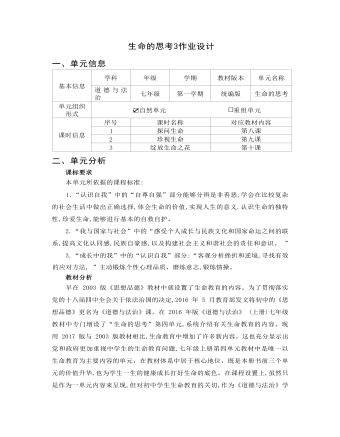
初中道德与法治七年级上册生命的思考3作业设计
一、单项选择题1.C 此题考查生命的特点,AD 选项前面说的都对,但是后面说的都不对。因为: 人生难免风险、挫折和坎坷,是逃离不了的,拒绝不了的。生命是独特的,不能 相互替代,所以 B 也是错的。C 符合题意正确。 2.①②③都体现对生命的尊重和敬畏,而④表达的是一种消极避世的人生态度 ; 因此错了。所以,正确答案 D。3.最美逆行不是没有安全意识,相反,他们能做到敬畏生命,坚持生命至上。因 此,②选项错了,其他选项都符合题意。所以正确答案是 D。4. (1) 主题是:敬畏生命(2) 图 1,祭奠生命,表达对逝者的追悼和怀念。这么做是为了悼念生命,体 现对生命的尊重,体会生命之间是息息相关的。图 2,生命是崇高的、神圣的,是任何代价都换取不来的。我们对生命要有一种 敬畏的情怀。
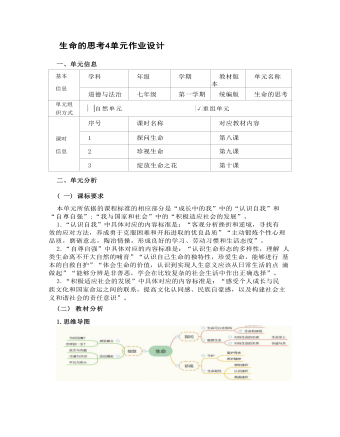
初中道德与法治七年级上册生命的思考4作业设计
①②③分析题干中,我们生命的意义不在于长短,而在于对社会的贡献,将个体生 命和国家的甚至人类的命运联系在一起时,生命就会闪耀出伟大,活出自己的精彩,让 生命更加绚烂,故①②③说法符合题意;④“追求生命个性和韧性”说法不符合主题故 ④说法错误;2.C【设计意图】该题考查呵护食品安全,珍爱生命。 ④说法虽然正确的,但是主体不符,不是市民的做法。故不能入选。 3.A【设计意图】本题考查对生命的传承。①②④材料中的话意在告诉我们,在人类生命的接续中,我们应该为自己的生命找 到一个位置,担当一份使命;在生命的传承关系中,我们应该正确认识和面对自己的生 命;我们每个人都不仅仅是在身体上接续祖先的生命,也在精神上不断继承和创造人类 的文明成果,故①②④说法正确;③生命属于我们每个人,生命的接续和发展与我们每 个人息息相关,故③说法错误。

初中道德与法治七年级上册生命的思考作业设计
B 等级——较积极参与采访活动;采访思路较清晰,记录较完整;能对自己的生 命观、价值观有所反思;能主动展示心得体会。C 等级——基本上能参与采访活动,遇到困难会想放弃;记录信息较少,只有少 量与主题有关;对自己生命观、价值观理解不深;有一点成果反馈,内容过于简 单。总体评价结果: (四) 作业分析与设计意图这是一项基于素质教育导向的整体式课时作业设计,以培养学生核心素养为 目标。作业以学生的“生命故事访谈”为主要情境,以填写活动记录的形式呈现。 教师从“参与态度、思想认识”等四个维度对作业进行评价,以“优秀、 良好、 合格”三个等级呈现。本次实践性作业是访谈型作业,课前采访希望通过学生的 参与,一方面锻炼学生的人际交往能力和口头语言表达能力,另一方面扩展学生 的生活阅历,从他人的精彩故事中获得启示,激发学生对生命的热情,树立正确 的人生观,同时也为下一框题的“平凡与伟大”提供教学素材,活出自己生命的 精彩。
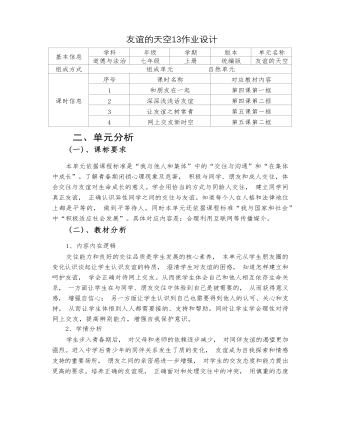
初中道德与法治七年级上册友谊的天空13作业设计
作业二(一)、作业内容情境探究、互联网将地球缩成一张小小的“网”。在这张“网”里,我们可 以发布信息、浏览新闻、结交好友等,为我们的人际交往扩展了新通道。情境一 中学生小强在一个论坛上认识了小胡,他们在很多问题上看法一致, 很快成为无话不谈的好朋友。经常彻夜长谈兴趣爱好、闲聊家庭状况、相约打游 戏。 有一天,小胡邀请小强一起去参与网络赌博,小强犹豫了。(1)请运用《网上交友新时空》的相关内容,结合材料,谈一谈:对于这样的网 友,小强应该怎样做?情境二 小强拒绝小胡以后,开始找借口疏远小胡。小胡察觉后,开始“变脸” 邮寄各种恐吓信和物品到小强家。小强忍无可忍选择了报警。(2)小强的网络交往经历,给我们中学生参与网络交往哪些建议?

初中道德与法治七年级上册师长情谊8作业设计
(四) 作业分析与设计意图这是一项基于素质教育导向的整体式课时作业设计,以培育学生课程核心素 养为目标,为了培养学生的基本道德修养和社会责任感,养成良好的行为习惯, 作业以劳动活动的方式呈现,特开展“帮助父母做家务”社会实践活动。教师通 过学生活动成果的展示,从“计划合理,联系实际;操作具体,善于思考;记录 完整,汇报详细;总结全面,反思深刻”等 4个维度对作业进行评价,以“优秀” “良好”“合格”三个等级呈现。通过家务实践活动让学生体验到父母工作的辛 苦和劳动的光荣,感谢父母对自己无微不至的关怀和照顾。让学生在接受爱的同 时学会关爱,学会付出、学会回报,懂得孝亲敬长。这种劳动实践的作业设计与 实施,有利于推进中小学劳动教育,落实劳动教育指导纲要,保障劳动教育时间,创新劳动教育载体,拓展劳动教育实践场所,推动劳动教育常态化有效开展,充 分发挥劳动教育综合育人作用。增强学生的责任意识,在实际生活中能自觉分担 家庭责任,具有较强的责任感。


